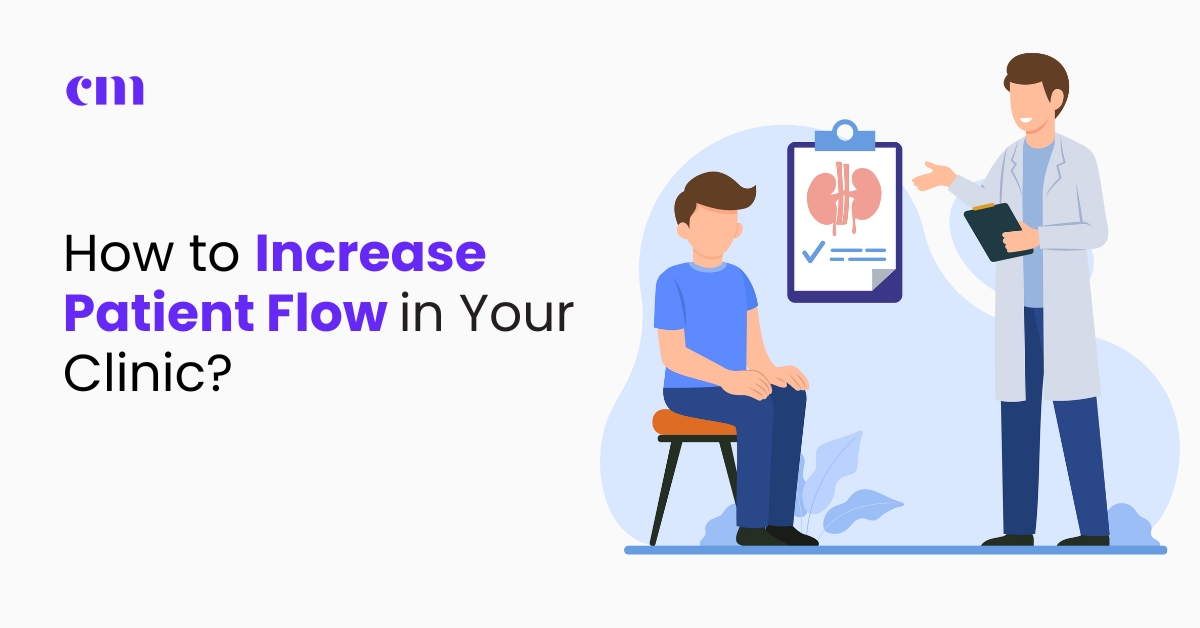Increasing patient flow in your clinic is crucial for maintaining efficient operations, improving patient satisfaction, and boosting clinic revenue.
Contents
ToggleThis guide covers comprehensive strategies to help you increase patient flow in your clinic while keeping quality of care intact.
Below, we explore actionable steps, supported by data, and use of technology to optimize patient movement from registration to discharge.
11 Steps to Increase Patient Flow in Your Clinic
1. Optimize Scheduling with Technology
Utilize Online Scheduling Tools
Implementing an online appointment system allows patients to book, reschedule, or cancel appointments 24/7.
This minimizes no-shows and maximizes time efficiency by filling in canceled slots quickly.
Clinics that adopt digital scheduling tools reduce administrative tasks and offer more flexible patient options, leading to an increase in clinic capacity.
Integrate EHR and CRM Systems
Electronic Health Records (EHR) combined with a Customer Relationship Management (CRM) platform creates a 360-degree view of each patient.
Clinics using EHR can reduce wait times by streamlining documentation, ensuring that patient histories and test results are readily available.
This eliminates delays associated with manual paperwork, which is one of the primary causes of bottlenecks in patient flow.
2. Triage Systems for Efficient Onboarding
Establish a Triage Framework
By assessing a patient’s condition during the intake process, clinics can prioritize those who require urgent care, ensuring quicker attention for critical cases.
This prevents clogging up valuable physician time with minor cases, improving the clinic’s ability to handle more patients daily.
Patient Pre-screening Before Visits
Telehealth or pre-screening questionnaires help identify which patients can be seen virtually or require physical visits.
This reduces the number of in-person visits and frees up valuable resources for those who need face-to-face consultation.
3. Reduce Bottlenecks in Workflow
Bottleneck Analysis
Perform a workflow bottleneck analysis to identify delays in patient movement.
Start by mapping your entire clinic workflow and identifying areas where time is being wasted.
These areas may include lengthy check-in processes or delays in processing test results.
Once identified, you can streamline these steps by either automating them or increasing staff efficiency.
Simplify Administrative Tasks
Front-desk operations can be another source of delay.
Train your staff to resolve minor issues quickly and handle multiple tasks efficiently.
Introducing self-service check-in kiosks, for instance, helps patients check themselves in, reducing the burden on your front-desk team.
4. Optimize Clinic Layout and Navigation
Improve Clinic Navigation
If your clinic has a confusing layout, it can slow patient movement, leading to inefficiencies.
Use clear signage, floor decals, and intuitive color codes to guide patients.
Additionally, gather patient feedback on navigation to make improvements based on their experiences.
Efficient Bed and Room Management
Real-time bed or room availability dashboards help staff know which examination rooms are ready. By coordinating with cleaning and preparation teams, you can reduce the time between patients occupying rooms.
5. Improve Communication and Coordination Across Departments
Interdepartmental Coordination
One of the primary causes of delays in clinics is poor communication between departments.
Miscommunication can lead to unnecessary wait times, delayed treatments, or even errors.
Establishing standardized patient transfer protocols between departments (such as from diagnostics to treatment) ensures that patients transition smoothly from one step of care to another.
Use Communication Tools
Leverage healthcare CRM platforms or internal communication tools that provide real-time updates to staff about patient status.
For instance, if a patient’s lab results are delayed, the platform can alert the care team immediately so they can adjust accordingly, minimizing disruptions in the patient’s care flow.
Read:
- 10 Ways to Develop a Patient-Centric Marketing Campaign
- 9 SEO Strategies for Doctors: Attract More Patients Online
6. Reduce Wait Times and Delays
Analyze Peak Times
Many clinics experience peaks in patient visits during specific hours or days.
By analyzing patient flow data, you can better prepare by increasing staff or extending hours during these peak periods.
For example, research shows that discharging patients before 11:00 a.m. can reduce inpatient bed wait times by up to 25%.
Implement Virtual Waiting Rooms
A simple way to reduce physical congestion and perceived wait times is to introduce a virtual waiting room system. Patients can check in remotely from their smartphones, receive real-time updates, and wait in the comfort of their own space until it’s their turn.
This increases patient satisfaction and helps to maintain social distancing guidelines in crowded clinics.
7. Improve Patient Experience with Proactive Discharge Planning
Early Discharge Planning
Effective discharge planning is essential to ensure a smooth transition from clinic to home care. It reduces the likelihood of patient readmission, increases bed availability, and helps streamline patient movement.
Clinics that engage in proactive discharge planning reduce patient readmission rates and improve overall patient satisfaction.
Post-discharge Support
Follow-up appointments and clear communication of post-discharge care plans can help ensure patients continue their care smoothly outside the clinic.
Providing easy access to telehealth consultations for follow-ups can further enhance patient satisfaction and free up more in-person appointment slots.
8. Train and Empower Staff
Regular Staff Training
Front-desk staff, nurses, and support staff are essential to maintaining an efficient clinic flow. Regular training ensures that they can handle administrative tasks quickly, resolve patient issues, and assist in the overall patient flow process. Well-trained staff can address minor patient concerns without escalating them to physicians, freeing up doctors’ time for more critical care.
Empower Staff to Make Decisions
Giving staff the authority to make real-time decisions—such as adjusting appointments, moving patients between rooms, or answering queries—can prevent bottlenecks from escalating. Empowering staff at all levels ensures smoother operations and reduces unnecessary delays.
9. Leverage Data Analytics and Feedback
Use Data for Continuous Improvement
Regularly analyze data on patient flow, waiting times, appointment efficiency, and patient satisfaction. Look for patterns that indicate inefficiencies, and adjust staffing, scheduling, or layout as necessary. For instance, by analyzing patient satisfaction surveys, you might discover that certain times of the day are prone to longer wait times, allowing you to better allocate resources.
Patient Feedback Loops
Creating a feedback loop where patients can rate their experience and make suggestions ensures that your clinic stays focused on improving service quality.
Feedback can reveal hidden inefficiencies in patient flow and help you address them effectively.
10. Adopt Telemedicine and Digital Health Solutions
Telemedicine for Routine Consultations
Telemedicine is a powerful tool to increase patient flow in your clinic by freeing up physical appointment slots.
Routine check-ups, follow-ups, or consultations that don’t require in-person interaction can be moved online. According to a recent survey, clinics adopting telemedicine saw a 20-30% increase in available appointment slots.
Automated Patient Reminders
Missed appointments are a significant contributor to inefficient patient flow. Implementing automated SMS or email reminders can reduce no-shows by 30%, ensuring your clinic operates at full capacity.
11. Use Efficient Layout Design
Optimize Clinic Layout
A well-organized layout reduces patient confusion and speeds up their movement within the clinic. Clearly marked signage, open pathways, and intuitive room placement ensure patients don’t waste time navigating the facility. Clinics that redesigned their layout for easier navigation reported a 15% reduction in patient delay times.
Centralized Waiting Areas
Instead of having patients wait in multiple areas, centralize the waiting area where all departments are easily accessible. This reduces patient confusion and makes it easier for staff to manage the flow.
Concluding Thoughts
By implementing these comprehensive strategies, your clinic can significantly increase patient flow, improve patient satisfaction, and boost operational efficiency.
The key to long-term success lies in regularly assessing and adapting these practices to your clinic’s unique needs.


